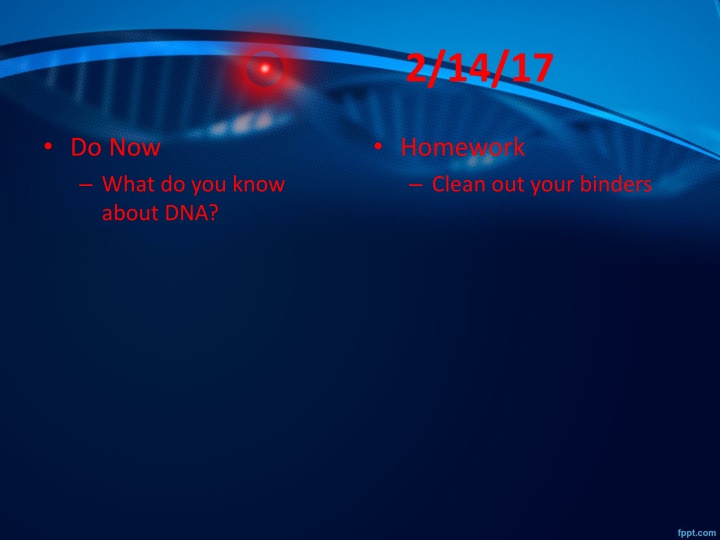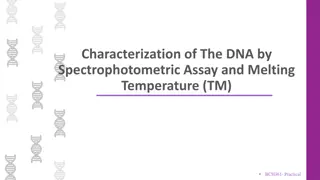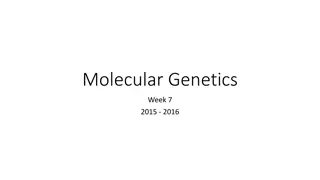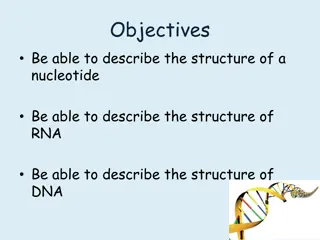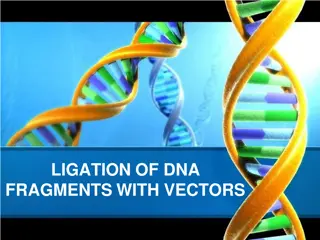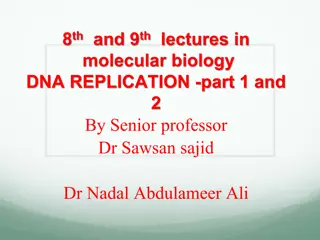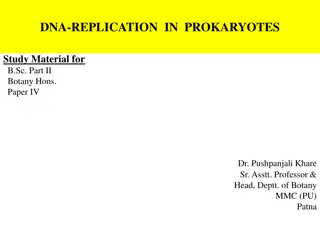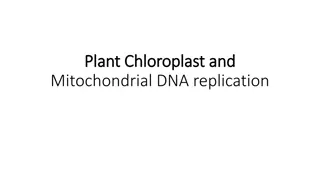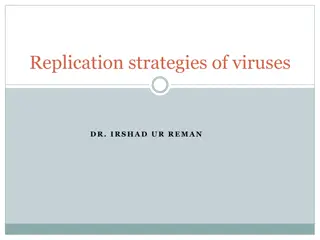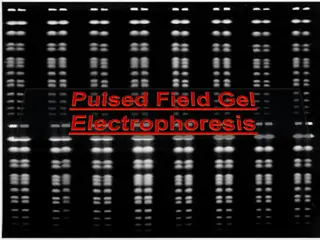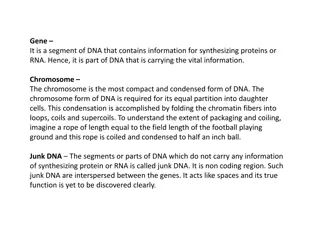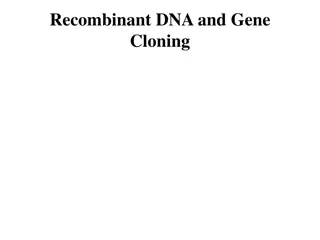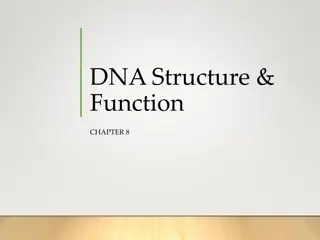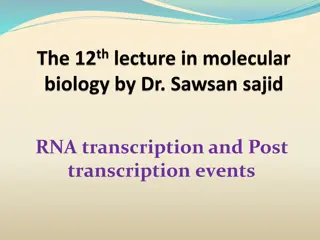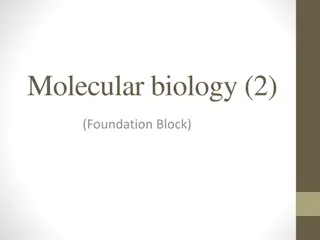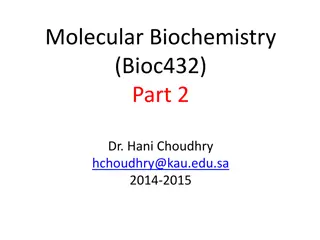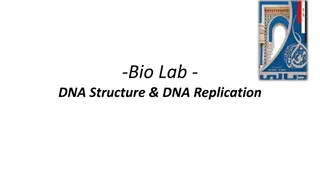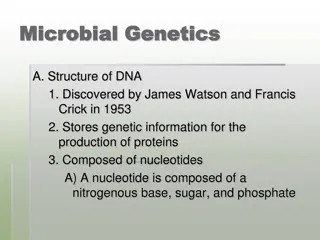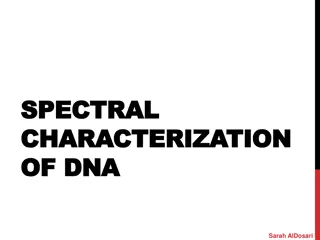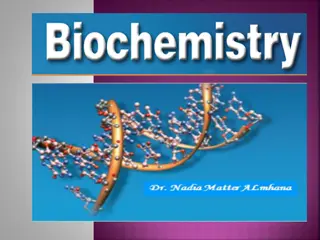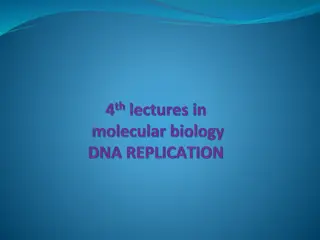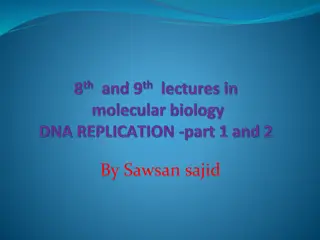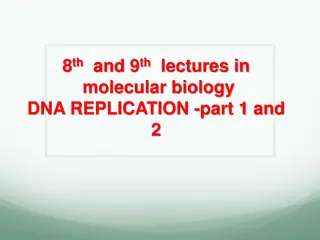DNA: Structure, Function, and Replication
Delve into the world of DNA with this comprehensive guide covering DNA structure, genetic traits, bases, nucleotides, and replication mechanisms. Discover how DNA controls inherited traits and understand the importance of nitrogen bases in coding genes. Uncover the secrets of the double helix structure and explore the intricacies of DNA replication. Unravel the mysteries of genetics and enhance your knowledge of molecular biology through an engaging exploration of DNA.
Download Presentation

Please find below an Image/Link to download the presentation.
The content on the website is provided AS IS for your information and personal use only. It may not be sold, licensed, or shared on other websites without obtaining consent from the author.If you encounter any issues during the download, it is possible that the publisher has removed the file from their server.
You are allowed to download the files provided on this website for personal or commercial use, subject to the condition that they are used lawfully. All files are the property of their respective owners.
The content on the website is provided AS IS for your information and personal use only. It may not be sold, licensed, or shared on other websites without obtaining consent from the author.
E N D
Presentation Transcript
2/14/17 Do Now What do you know about DNA? Homework Clean out your binders
Who are you? This question can be answered many ways Personality traits Kindness Vegetarian or Carnivore Competitiveness ***Traits you can control
Who are you? This question can be answered many ways Physical Traits Height Eye color Hair color and texture Foot size Bone strength ***Traits you can t control
Who are you? DNA controls your inherited traits DNA is given to each new daughter cell in the cell cycle to ensure that genetic information and traits are maintained.
DNA Structure DNA has a structure we call a double helix Discovered by Watson and Crick DNA double helix DNA backbone Bases
Bases are Important! There are four nitrogen bases: Adenine A Thymine T Cytosine C Guanine G The order of these bases along a strand of DNA codes for your genes.
DNA is Picky Just like a model wearing a suit jacket with suit pants, or a t-shirt with blue jeans, A only pairs with T and G only pairs with C. You put air (A) in your tires (T) You put gas (G) in your car (C)
Nucleotides Each of the 4 nitrogen bases will join with a sugar and a phosphate to make a nucleotide DNA is made of a sequence of nucleotides
DNA Replication DNA will unzip, and allow for 2 new copies of DNA to be made. How? Uses the base pairs to see what piece needs to be added to the DNA next
DNA Replication https://www.youtube.com /watch?v=zdDkiRw1PdU
Grasshoppers Walter Sutton studied sex cells in grasshoppers Found 24chromosomes in body cells Found 12chromosomes in sexcells What???
Sex Cells Humans have 46 chromosomes in body cells Where does your DNA come from? Half from Mom, half from Dad How many chromosomes in sex cells? 23 Body cells have 23 pairs (46 total) of chromosomes Why pairs? One at each pair is from mom, one is from dad
Meiosis Process of creating sex cells from a body cell One cell will undergo division twice, creating 4 sex cells After two cell divisions, four cells with 23 chromosomes each are formed.
Twins Identical twins are born with the same DNA Fertilized egg will split Fraternal twins are born with separate DNA Two different eggs fertilized by two different sperm Much like regular brothers and sisters
Twins Identical twins later in life do not have the same DNA How? Studies found that certain things can change the DNA over extended time Diet and smoking are thought to change DNA Mutations do change DNA
2/15/17 Do Now: Describe the structure of DNA Not just the name, describe the parts of DNA too Homework: Finish coloring activity if you did not already
How does this all fit together? DNA gets compressed and wound tight to form a chromosome
Genes Genes are found on chromosomes Genes have multiple alleles Dominant and recessive Each body cell has about 35,000 genes
Protein synthesis The order of the nucleotides in DNA controls what protein is to be made DNA is the instructions for making proteins Protein synthesis takes place in two steps Transcription Translation
Transcription The process of making a copy of the original strand of DNA This copy is known as mRNA mRNAis the messenger that carries the code to the _______________? Ribosomes Why do we need a messenger? DNA is in the nucleus, protein production takes place at the ribosomes. DNA cannot leave the nucleus
Translation mRNA is the information that arrives at the ribosomes Site of protein production Every 3 nucleotides on the mRNA is called a CODON Each codon codes for a specific amino acid to be added to the growing chain
Translation tRNA carries the amino acid and adds it to the chain rRNA connects all of the amino acids in the chain together
Translation Finished chain of amino acids is your protein! Video https://www.youtube.com/watch?v=gG7uCskUOr A
Mutations A mutation affects the way that proteins are made, which changes a trait about a person Substituting a base pair Deleting a base pair Inserting/Adding a base pair
Mutations Mutations can be good and bad Mutation that turns a rabbit white Help or hurt survival chances in a snowy area? Help or hurt survival chances in a wooded area? Mutation that increases resistance to bacteria Help or hurt survival chances?
DNA Replication And Protein Synthesis Comparison Both produce genetic material Both read the existing base pairs to determine the sequence of the new strand(s) Both start inside the nucleus
DNA Replication And Protein Synthesis Contrast DNA Replication Produces 2 new strands (DNA) Unzips the entire molecule DNA cannot leave the nucleus Protein Synthesis Produces 1 new strand (RNA) Only opens the molecule at the bubble RNA can leave the nucleus
2/16/17 Do Now: List the steps in protein synthesis Homework: Finish DNA secret code
Protein Synthesis Steps 1. DNA opens at the bubble 2. mRNA is created using the base pairs in DNA 3. mRNA travels to the ribosome 4. tRNA reads the codons in mRNA and adds the correct amino acids to the chain 5. rRNA finishes the chain of amino acids and makes it a protein
